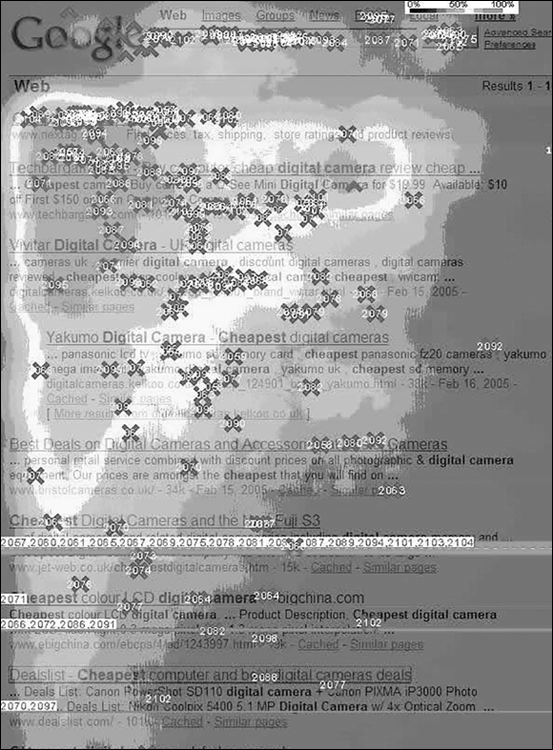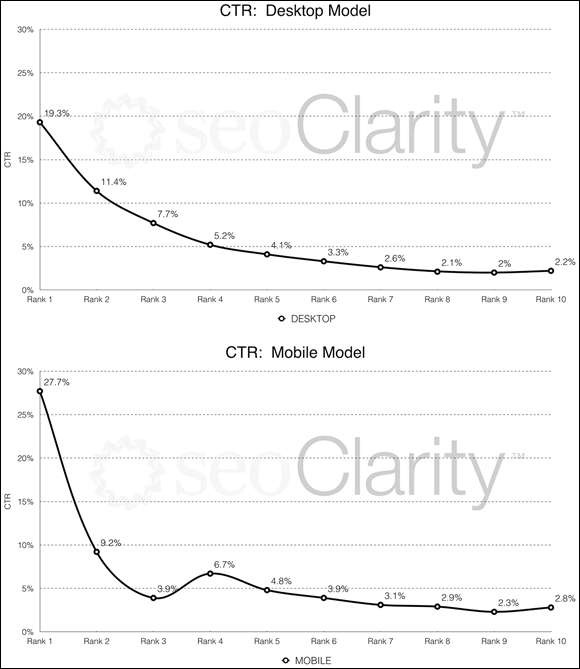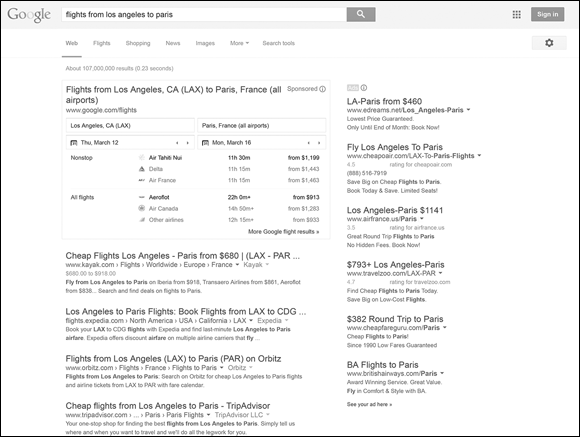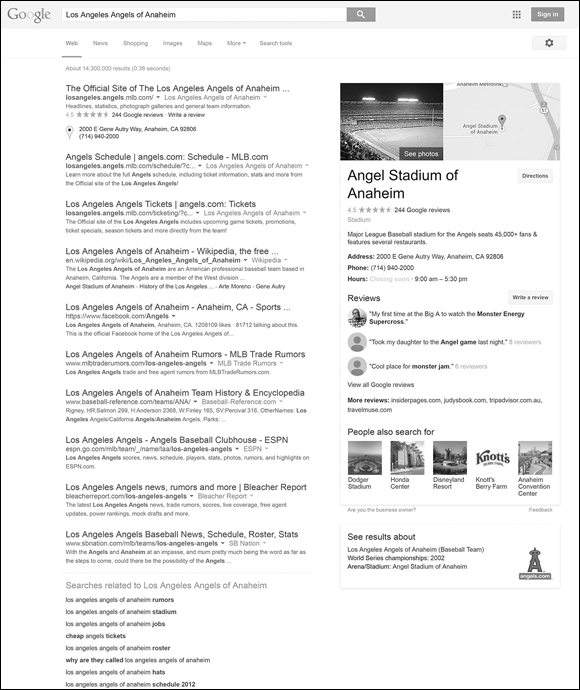Chapter 3
Recognizing and Reading Search Results
In This Chapter
- Reading the search engine results page
- Understanding the search results page and why rank position matters
- Identifying how mobile users search
- Discovering the effects of blended search
- Understanding the effect of Google’s Knowledge Graph
- Discovering the impact of semantic search and Hummingbird
In Chapter 2 of this minibook, we discuss organic versus paid results: organic results being the listings that are ranked by perceived merit by a search engine, and paid results (also called sponsored results or sponsored links) being purchased ads that appear along with the organic results. In this chapter, you discover what the rest of the results page means, find out about what gets the most attention on a search page, how search results appear for mobile searchers, and how search engines are adapting to the rising use of voice search.
Reading the Search Engine Results Page
Say that Mother’s Day is coming up and you want to buy your mother a nice bouquet of roses. (Good for you! No wonder Mom always liked you best.) After going to Google and typing your [bouquets] search query into the box, you’re presented with a results page. The results page contains many different listings containing the keyword, or search word, [bouquets], sorted according to what Google thinks is most relevant to you. Figure 3-1 shows a Google results page for the query [bouquets].

Figure 3-1: A typical Google search results page.
Take a look at the different parts of the page shown in Figure 3-1. (Note that we’re using a Google results page because Google gets the lion’s share of traffic. Plus, there isn’t much difference between Google’s results-page layout and those of Yahoo and Bing.)
- Search Box: The box where you type your search query, or whatever it is that you’re looking for. In this case, it’s bouquets.
- Search Verticals: Links to the vertical search engines, the specialized ones that narrow your search to a specific type of result, such as images or news. Clicking one of these links takes you to a results page with only images or only shopping results, for instance.
- Page Count: The number of web pages Google found that matches your search query in some way. In Figure 3-1, we have a lot of pages in our results.
- Time Search Took: How long the search engine took to retrieve your results.
- Organic Results: The listing results from a general search of Google’s index, with algorithms applied to determine relevance.
- Ads: The paid advertising links. These are marked as “Ads” (or sometimes “Sponsored”) and usually appear to the right of the organic listings or above them.
- Local Map Results (“local pack”): Local businesses considered to be relevant to the query, pulled from Google’s local index.
- Map: Visual map of the local area with markers to show where all the local map result listings are located.
- Images: Picture files that match your query. These come from Google’s Images vertical engine. Clicking the text link would take you to the vertical search results; in this case, a page containing only images of bouquets.
- Related Searches: Other topics that contain your query or other searches Google thinks might be relevant.
- Pagination: Links to the additional pages of results.
- Sign In: Google encourages users to be signed in to their Google accounts, which enables the search engine to track their behavior and personalize their results. When you are signed in, you’ll see your picture and a different set of buttons in the upper-right corner.
Other SERP Features: There are many additional display options that Google might include on a given search results page. In fact, it’s hard to get the same SERP twice! Some of the most innovative features come from what Google calls its Knowledge Graph, which is a database of information connecting people, places, and things; we explain more about this later in the chapter.
Understanding How People Look at Search Results
Knowing what is on the results page is important, but so is understanding how people read it. As it turns out, there is actually a predictable pattern in the way people read a results page. Eye-tracking studies show that, just as Google’s SERP has changed a lot over the past decade, people’s behavior when viewing results has similarly evolved.
Back in 2005, a ground-breaking study was conducted to track people’s eye movements while reading a typical search engine results page. The study, done by Enquiro Research, which was later acquired by Mediative, discovered a pattern that it called the Golden Triangle. The Golden Triangle identified on a visual heat map how people’s eyes scan a results page and how long they look at a particular result before moving on. Figure 3-2 shows that originally, people reading a SERP tended to start in the upper-left corner and move down the page, and then out to the right when a title caught their attention. This eye-tracking pattern forms a triangle (or an F, as another research organization, the Nielsen Norman Group, observed in its 2006 study). For many years, the top three positions got almost all the user’s attention, with a little bit given to the middle of the page, and almost none for the last few results on the page.

Figure 3-2: Enquiro dubbed this 2005 eye-tracking study's results the Golden Triangle.
Times have changed, and so has the way users view search engine results. After acquiring Enquiro, the company Mediative followed up the research with a new eye-tracking study in September 2014. It found that a searcher’s gaze often travels outside the Golden Triangle area looking for what seems most relevant. Because Google’s SERP format can be different with every search, it’s no wonder people have learned to scan a greater portion of the page to find what they need.
As an example, the heat map in Figure 3-3 shows how searchers look at a desktop SERP that includes a local pack and map. Notice that the eye pattern goes down the page and over to the map on the right. The most time is spent looking at the top listings in each of the various display formats down the page: two paid ads at the top of the page, the reviews section, the top two local listings, and the first organic listing below the local pack.

Figure 3-3: A heat map from Mediative’s eye-tracking study shows a different pattern.
The SERP pictured in Figure 3-3 is just one possible configuration. Also, Mediative’s study found that today’s searcher tends to view more of the listings but spend less time looking at each one (1.17 seconds compared to just under 2 seconds in 2005, according to the study). Searchers also tend to look farther down the page, perhaps because smartphones have conditioned people to scroll vertically. Whatever the reason, Google SERPs have taught people to check out more than just the top-left results. That means more opportunity to be seen in the SERPs — though your listing has only about a second to make a good impression.
Searcher behavior on mobile devices is another thing entirely. As we mention earlier, people routinely and quickly scroll down. But that doesn’t mean that the ranking advantage is spread evenly among the top results.
Identifying Mobile Users’ Search Patterns
At the start of 2014, it finally happened: Internet use via mobile devices actually exceeded desktop Internet usage in the U.S. for the first time. Face it, everyone has a smartphone these days, and people are increasingly using those handy devices, tablets like the iPad and the new midsize range of phablets (oversized phone-tablet devices) to go online.
Website owners need to take this trend seriously. If your website is not mobile-friendly, you’re probably already losing business, or turning off potential customers. People are not as forgiving as they once were with a slow-loading page or a site that doesn’t resize well on a small screen. If that’s a concern, you can find lots of help optimizing your site for mobile users over in Book IV, Chapter 3. But here, we look at how users view search on a mobile device.
Mobile SERP features
Mobile devices range from smartphones to tablets, with many different sizes of screens. Because the viewing area on a mobile device is usually much smaller than a desktop computer screen, users have gotten used to scrolling quickly to see more. Sometimes not much shows in the initial view. Figure 3-4 contains iPhone results of a search for [Lakers tickets] using the Google search app.

Figure 3-4: Mobile search results on an iPhone.
In this instance, the search for [Lakers tickets] turned up two ads sitting squarely at the top, blocking nearly all the organic results below them. Unlike with a desktop SERP, the searcher cannot just scan to find a relevant listing. The only remedy is to scroll down.
Eventually, this search results set displays lots of organic listings plus additional SERP elements such as images and news article links. But it takes some finger scrolling to see them.
Mobile’s impact on ranking
It turns out that searcher behavior is a lot different on a mobile device, and this difference puts ranking positions in a slightly new light.
A very interesting study by seoClarity looked at click-through rates (the percentage of time a user clicks on a listing) on desktop versus mobile SERPs. The study tracked clicks over a three-month period (June–August 2014), a period that avoids much seasonal fluctuation. Figure 3-5 shows the results of the study in two line graphs — one showing the CTR (click-through rate) for all the different ranking positions on desktop SERPs, and the second for mobile SERPs.

Figure 3-5: Comparing click-through rates on desktop versus mobile (from seoClarity).
In the top graph, desktop click-throughs show the typical curve we’d expect to see — the top ranking position gets the most clicks, with the remaining rankings descending in click-throughs from there. So being No. 2 is better than being No. 3, No. 3 is better than No.4, and so on down the page.
Not so for the mobile SERP. The study found that CTR does not follow a predictable linear pattern from one ranking position to the next. The top spot still receives the most clicks, and the second position the second highest number of clicks. But the next best place to be is No. 4, according to the study, followed by No. 5. The third position’s CTR falls in a trough, with the same low CTR as No. 6.
Another interesting thing to note: Look at how many more click-throughs the top-ranking position gets on a mobile SERP versus desktop — 27.7 percent of mobile users clicked the first result, compared to only 19.3 percent on a desktop SERP! Doesn’t that make you want to rank in mobile search?
Discovering the Features of a Search Results Page
We’ve already covered how search engines can display various types of content besides just text links on a results page. In this section, you dig deeper into what makes up all those different elements, which ones you as a site owner can influence, and what it all means to you as you aim your SEO campaigns.
Blended results
The term blended results (dubbed Universal search by Google) refers to the integration of results from many different verticals into a SERP. Google started this trend years ago, and now all the major engines blend together different types of results. The intent of this blending is to increase the chance that the results will satisfy the user’s needs.
Most SERPs today contain blended results. In fact, about 81 percent of Google searches bring back a blended SERP, based on a December 2013 study by Searchmetrics. The study revealed that videos and images show up the most often, as Table 3-1 shows.
Table 3-1 Universal Search Integrations in Google.com
Vertical Result Type |
Frequency of Appearance in SERPs (Market Share)* |
Videos |
14 percent |
Images |
35 percent |
News |
6 percent |
Shopping |
44 percent |
Maps |
1 percent |
* Note: Market shares add up to more than 100 percent because SERPs can contain more than one type of blended result.
Effects of blended search
You can see why blended search impacts search engine optimization in a big way. The eye-tracking research shows how people skip around a SERP in order to find what they’re looking for. Adding an image to the search results, especially one that pops up high on the page, leads searchers’ eyes to jump to it, making the spots above it on the page not as important as they used to be. That means that, in a blended results page with an image, instead of being the No. 1 or No. 2 result, you might actually be happier in the No. 4 spot, under the image where the eye will naturally jump to next.
Knowledge Graph
The Knowledge Graph is a database system launched by Google in May 2012. Beyond just storing facts, the Knowledge Graph connects information about various entities (people, places, and things) to understand how they are related. The Knowledge Graph enables Google to take all those facts in its database and start to make sense of the connections between them. Not only does this type of understanding help the search engine decipher what a searcher is asking for, it also affects the results.
Effects of the Knowledge Graph on SERPs
Knowledge Graph elements show up in all kinds of ways on Google SERPs. With such a vast knowledge repository, Google often takes the direct route and displays just what (it thinks) the searcher wants to know right on the results page. Users benefit because they can get a quick answer to their question without even leaving Google. Website owners have mixed feelings about the Knowledge Graph, because while it’s possible to get your own site quoted or linked to from within a KG element, more often Google seems to be competing with websites for clicks. We talk more about how to deepen your site content to hold your own against the Knowledge Graph in Book V, Chapter 3.
Figure 3-6 shows an example of the Knowledge Graph at work. Searching for the query [flights from Los Angeles to Paris] brings up a SERP that displays no organic listings above the fold at all. Ads appear at the top and right column, as usual. Below that is an interactive Knowledge Graph element that lets you choose your travel dates and see flight choices and prices. Organic web links for Kayak, Expedia, and the rest of the usual travel sites do appear on this SERP but are visible only if the user scrolls below the Knowledge Graph feature.

Figure 3-6: An interactive Knowledge Graph element in a Google.com SERP.
Other Knowledge Graph features take up less space or are arranged in a less obstructive way (from an SEO point of view). For example, Figure 3-7 shows a Google SERP for the query [Los Angeles Angels of Anaheim]. The engine interprets what the searcher might be after, and the search engine dishes up organic links to websites about this baseball team with blended results from the Google Images and News vertical engines as well as the following Knowledge Graph elements:
- Game information about the team’s next scheduled game
- Stadium picture, map and background information, as well as user reviews and links to search results pages about upcoming events

Figure 3-7: Another Google SERP showing Knowledge Graph elements.
Hummingbird and the semantic search revolution
On September 26, 2013, Google dropped a bombshell on the search industry: It announced that its search algorithm had been completely rewritten and had been live for over a month already. The startling thing was that the transition had been so seamless, virtually no one had noticed! Nevertheless, under the hood, the new algorithm (named Hummingbird) revolutionized Google’s approach.
When Hummingbird flew in, the old way of just matching up strings of characters in a search query to web pages containing those character strings went out the window. With Hummingbird, Google’s method changed “from strings to things.” Hummingbird transformed Google from a search engine into a knowledge engine.
The search engine’s goal, as always, is to make search results more relevant to the user’s actual intent. But the new way of doing that which Hummingbird ushered in is more broadly known as semantic search. In a semantic search world, the search engine begins with user intent and tries to understand the query itself, not just the keywords in the query. Basically, a semantic search engine tries to understand the meaning and context just as a human would. Next, semantic search technology seeks to extract entities from its database as answers and display personalized search results that are just right for the individual user.
Effects of Hummingbird on search
Earlier in this chapter, we tell you about how the Knowledge Base has changed search results by using injected answers right alongside the ads, blended results, and organic listings. That’s happening across the board in the main SERPs for the majority of text and voice searches across all types of devices. With Hummingbird’s semantic search technology, Google has been able to improve the accuracy of those answer boxes and other KG elements. But Hummingbird has had an even greater effect on how people enter a search.
Hummingbird paved the way for voice search, or the ability to search by speaking a query into a search engine using a smartphone or other device. The ability to understand spoken search queries in terms of user intent and contextual meaning, such as are found in spoken conversation, is an advanced application of semantic search.
Consider how you’d talk to your friend about a movie you want to see. “Did you see the trailer for ‘Awesome Flick II’ yet?” you might say as an opener. When your friend responds, you can continue discussing the movie — the lead actors, why you’re excited, the special effects, where it’s playing, and so on. In all that conversation, you probably never say “Awesome Flick II” again (hopefully not!). But your friend isn’t confused by your wanton use of pronouns; the conversation topic remains clear.
Imagine being able to talk to a computer that way. Semantic search is revolutionizing how people search because they can interact not in keywords, but in conversational style. And this is especially true for mobile.
Mobile use is growing across the globe, and with it the number of searches performed on a smartphone or tablet. In response, the search engines and mobile device providers are cranking out software to win the race to provide the best user experience. A big part of that is how well the device can provide answers to a user’s questions.
Not surprisingly, Google’s version of voice-assisted search is currently way out in front of the pack. (See the sidebar “Meet the voice assistants” for details.) Because Google has access to data not only from search, but also from other Google properties, including YouTube, Google Drive, Gmail, Google+, and more, it’s likely to continue setting the standard in semantic search.

 Understanding how changes to the search results page and different search platforms can affect traffic and click-throughs is important. Even when the SERPs change in look and feel, you can make an educated guess about the effect of those changes based on the trends discussed in this section. Keeping up with the changing SERPs and how to fine-tune your optimization campaign in response is an important part of SEO.
Understanding how changes to the search results page and different search platforms can affect traffic and click-throughs is important. Even when the SERPs change in look and feel, you can make an educated guess about the effect of those changes based on the trends discussed in this section. Keeping up with the changing SERPs and how to fine-tune your optimization campaign in response is an important part of SEO.